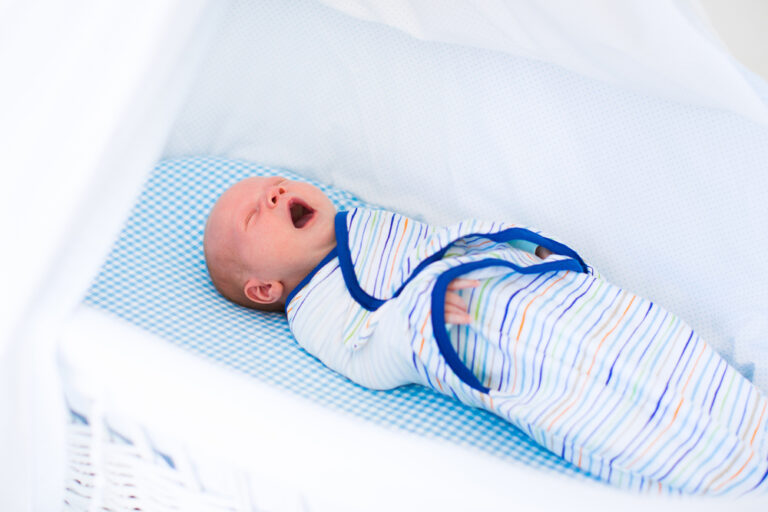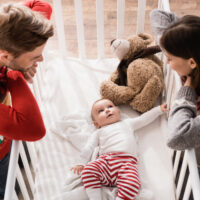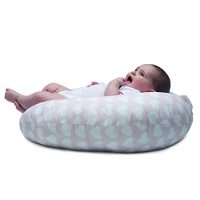Any parent of a newborn knows that swaddling is an absolute game-changer. It helps babies transition from the cozy womb to the outside world by controlling their startle reflexes and calming them to sleep. But little ones must have their arms free from the swaddle as soon as they show signs of rolling to keep them safe. In this article, we will discuss when babies are usually ready to graduate from newborn swaddles and the signs to look out for.
The Science Behind Safe Swaddling
Before we dive into when you should stop swaddling, it is important to make sure that you are swaddling correctly to begin with.
According to the AAP (American Academy of Pediatrics), swaddling is an effective technique when done properly to promote sleep and help calm infants. All babies are born with the Moro reflex or “startle” reflex. A subtle change in a baby’s surroundings can trigger a response, which includes extending their arms and legs rapidly. This motion can jerk a sleeping baby awake!
Enter the magical swaddle. Swaddles recreate a womb-like environment, baby’s first home, and soothe little ones when they experience the startle reflex by tucking their arms.
But it is important to follow safety measures to make sure babies are swaddled correctly.
- No fabric covering nose and mouth: Wearable swaddle blankets (often with velcro and zippers) are preferred over loose blankets. Loose swaddles could block baby’s airwaves.
- Loose hips: Babies who are swaddled too tightly could develop a problem with their hips. When swaddled, babies should be able to bend their legs up and out.
- Prevent overheating: While they look like adorable burritos when swaddled, be sure little ones are not too warm. Signs of overheating include sweating, damp hair, flushed cheeks, heat rash, and rapid breathing.
- Back to sleep: It is imperative that babies, swaddled or not, are placed on their backs for naps and nighttime sleep. This decreases the risk of suffocation.
RELATED: Best Sleep Sacks for Baby
When to Stop Swaddling
As we discussed, babies should not be swaddled with arms restricted when they show signs of rolling. Notice: swaddling with arms in needs to stop even before they can roll. This is to make sure that babies don’t roll for the first time in their sleep while swaddled. When babies roll from back to tummy, they need their arms to push up and to lift their heads out of the crib mattress in order to breathe.
So when do babies show signs of rolling? This is different for each baby. Many babies work on rolling around 2 months of age, even though they may not do it intentionally until 4 months of age.
The best way to know when your baby is showing signs of rolling is to monitor him or her closely during awake times. Be sure to give your little one plenty of tummy time, even though they may hate it! Start with a minute or two at a time and gradually increase the time spent on strengthening their neck control.
Also, monitor your baby when he or she sleeps. Keep a baby monitor or camera if they sleep in another room, so you can check on your precious little one throughout the night.
How to Transition Babies from Swaddling
Babies often outgrow the Moro reflex around 3 to 6 months of age. So what is a parent to do if babies are not quite ready to graduate from a swaddle but you’re terrified that they may accidentally roll in their sleep?
The answer: transitional swaddles. These work similarly to newborn swaddles in that they provide cozy, snug comfort to muffle their startle reflex. The major difference is that arms are not restricted. So if your baby does rollover accidentally or intentionally in the middle of the night, their hands are free to push up from the mattress.
Baby Merlin’s Magic Sleep Suit
You will likely get a fit of giggles when you see your little one in the Baby Merlin Magic Sleep Suit for the first time. It is just too adorable, and they look a little bit like marshmallows. But this thing is a dream and a lifesaver!
If your baby’s startle reflex is still very strong, but you think he or she may start rolling or you’re terrified they might, this sleepsuit is the perfect transitional swaddle. It provides that cozy contained feeling to promote sleep.
There are a few things to keep in mind with this product, however, to make sure it is safe for your baby. First, do not use the Merlin Magic Sleep Suit when babies can roll over or if they try to roll over with the suit on. This swaddle transition is meant to be introduced around 3 months of age or about 12 pounds. It comes in 2 sizes: small (3-6 months, 12-18 pounds) and large (6-9 months, 18-21 pounds). Proper fit is very important for safety.
Another thing to keep in mind is that the Magic Merlin Sleep Suit is thicker than most swaddles on the market. It comes in 2 exterior fabrics: a soft microfleece or a cotton outer layer. Inside, there is a soft, breathable jersey cotton inner layer and a layer of polyfill. Babies should not wear socks or anti-scratch hand mittens with the suit. This is to make sure they do not overheat. It is recommended that the temperature in the baby’s room should be anywhere from 68 degrees to 72 degrees Fahrenheit. When using the Magic Merlin Sleep Suit with my daughter, she slept in a cotton short sleeve onesie underneath.
Babies should be sleeping on their backs, on a flat, firm mattress with nothing else in the crib when using the Magic Sleep Suit. This product is not meant for babies who co-sleep.
The Magic Merlin Sleep Suit has a wide scooped neckline to keep fabric away from baby’s face. It also has double zippers to make diaper changes a breeze.
Love To Dream Swaddle UP Transition Bag
Another genius transitional swaddle is the Love To Dream Swaddle UP Transition Bag. My daughter used this product for months and loved it.
This transition bag has patented zip-off arm wings to gently graduate your little one to arms-free sleeping. You can start with one arm out, then gradually move to two arms free. If your baby is not quite ready for arms-free sleeping, then you can keep both arms zipped up. Even with arms free, this transition bag mimics the feeling of being swaddled through the chest and torso, while leaving plenty of room for the hips and legs to move.
Love to Dream has a newborn swaddle (without the zip-off wings) that allows babies to be swaddled in the arms up position, as opposed to the usual arms tucked position. Love to Dream says it designed swaddles this way because most newborns are used to sleeping with arms up in the womb. If your newborn started with the arms up swaddle, transitioning to arms free should be fairly smooth.
I love the removable wings. You’ll find that your little one may find the wings and start sucking on them to self-soothe. It is great to remove the wings and easily hand wash them separately without having to wash the entire swaddle. There is also a double zipper to make middle-of-the-night diaper changes more convenient.
Nested Bean Zen One
Similar to the Love to Dream Swaddle Transition Bag, the Nested Bean Zen One offers removable arm wings to graduate your little one to arms-free sleeping.
The Nested Bean has a few key features. It is gently weighted to mimic the pressure your baby feels when being held. Even when arms-free, babies will feel snug.
It also has an armband inside the zippered sleep sack to give you the option of swaddling your baby with arms tucked. This is optimal for containing the startle reflex. The Zen One also has quick-drying mesh sleeves for thumb suckers. You can remove the sleeves when babies show signs of rolling.
Final Word
Newborns benefit greatly from swaddling when done properly. It helps recreate the womb, which they long for in those early days.
When to stop swaddling will be different for each baby, but experts say you should look out for signs of rolling as early as 2 months. For most babies, this may be closer to 3 months or so, but again, watch your baby.
You can still offer the effects of a soothing swaddle while graduating to arms-free sleeping. Transition swaddles are very helpful to promote restful sleep for your babe.
And when babies outgrow transition swaddles, it is a good idea to use sleep sacks or wearable blankets at least until 12 months of age, and even into toddlerhood. Babies should not have anything in their cribs or sleep environment until 1 year of age. That includes blankets, pillows, stuffed animals, etc. A wearable blanket ensures that your little one stays warm, comfortable, and safe at night.









